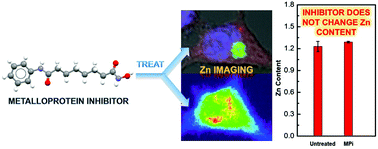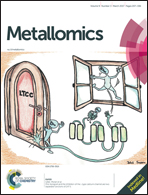The effect of metalloprotein inhibitors on cellular metal ion content and distribution†
Abstract
With metalloproteins garnering increased interest as therapeutic targets, designing target-specific metalloprotein inhibitors (MPi) is of substantial importance. However, in many respects, the development and evaluation of MPi lags behind that of conventional small molecule therapeutics. Core concerns around MPi, such as target selectivity and potential disruption of metal ion homeostasis linger. Herein, we used a suite of analytical methods, including energy-dispersive X-ray spectroscopy (EDX), inductively coupled plasma atomic emission spectroscopy (ICP-OES), and synchrotron X-ray fluorescence microscopy (SXRF) to investigate the effect of several MPi on cellular metal ion distribution and homeostasis. The results reveal that at therapeutically relevant concentrations, the tested MPi have no significant effects on cellular metal ion content or distribution. In addition, the affinity of the metal-binding pharmacophore (MBP) utilized by the MPi does not have a substantial influence on the effect of the MPi on cellular metal distribution. These studies provide an important, original data set indicating that metal ion homeostasis is not notably perturbed by MPi, which should encourage the development of and aid in designing new MPi, guide MBP selection, and clarify the effect of MPi on the ‘metallome’.

- This article is part of the themed collections: Metallomics Recent HOT articles and Zinc in the Biosciences


 Please wait while we load your content...
Please wait while we load your content...